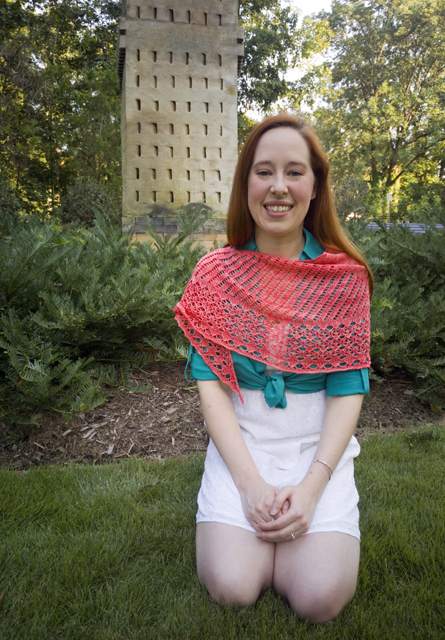
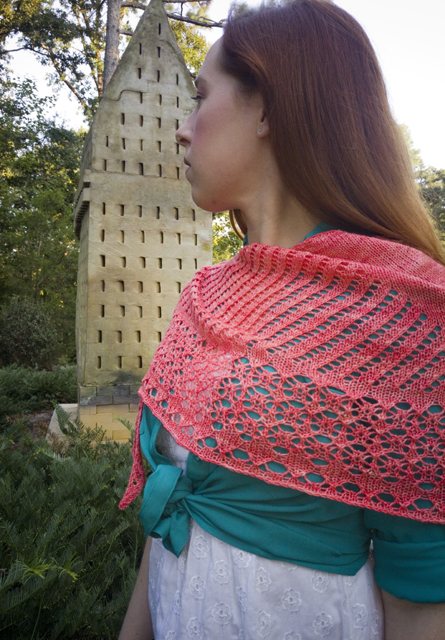
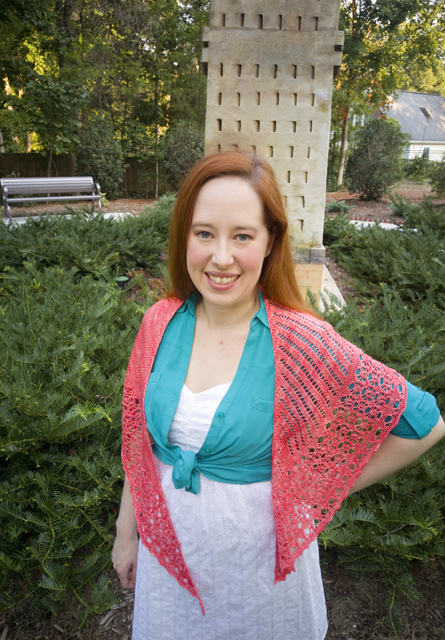
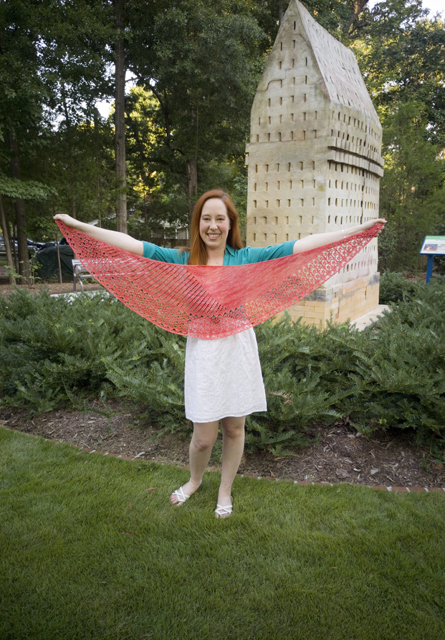
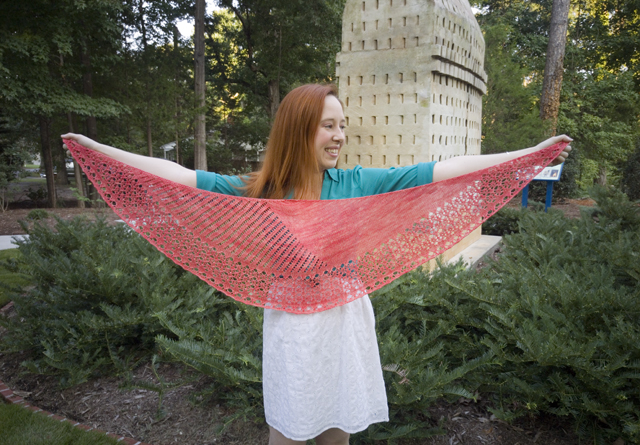
If it weren’t for the metadata attached to these photos, as well as a recently developed habit of scribbling dates on the paper copies of my patterns, I never would have been able to recall when I started or finished this project. Clearly at least a season ago, judging by the outfit. As it turns out, I knit up this shawl between the end of July and the beginning of August—nearly half a year ago.
The project didn’t begin with the knitting, though. No, it all started with the yarn, which began its life as the leftovers from my So In Love cardigan (Ravelry link), which apparently pre-dates this blog by a year. I had an entire skein still in my stash, the perfect amount for a shawl. But I didn’t really want another item in the exact same shade of pink, and I wasn’t sure that the slightly cooler tone would be particularly flattering near my face either. It was the perfect candidate for a little over-dyeing experiment. My goal was a warm, orangey-pink coral, which I hoped to achieve using Rit liquid dye and the stovetop method.
For my first attempt, I referenced the Favorite Rit Dye Colors handout and followed the recipe for Coral, which calls for 1/2 cup Petal Pink and 2 tbsp of Tangerine. (Interestingly, there’s another color with the same liquid dye decipe, called Sea Coral (Pink). They have different powder dye recipes, which, combined with my own results, leads me to believe that the Sea Coral one is a misprint.) The result was a saturated hue that was almost neon in its intensity, and more orange than I expected to boot.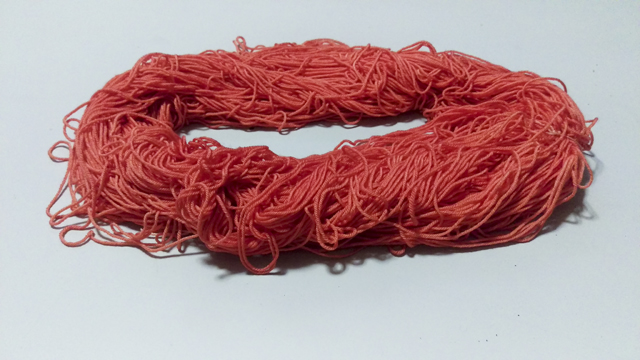
Despite its undeniable cheerfulness and perfectly even color, I didn’t love it. Since I considered the leftover yarn a bonus, I decided to gamble and try dyeing it again. But since I ultimately wanted a lighter color, I needed to strip the dye first. (Actually, I needed to untangle the yarn first, then remove the color. Long story short, I didn’t tie off the hank in enough places before dyeing, and my enthusiastic stirring yielded a rat’s nest that took the better part of a Saturday to unravel. Do yourself a favor and tie off the hank twice—three times!—as many times as you think you need before dropping it in the pot.)
I picked up a package of Rit Color Remover, which worked shockingly well—and fast. As soon as the yarn touched the water, it bleached to a natural cream color. I followed the directions for soaking, again using the stovetop method, and then rinsing. I honestly don’t recall if I also washed the yarn afterward as instructed, but if I did I would have used Eucalan as my detergent.
Sidebar: I suspect the wool content in Cascade Heritage Silk is made into a superwash yarn using a method that glues the scales down, rather than removing them, because after bleaching the yarn seemed a lot grippier, like a non-superwash wool would be. I think the bleach dissolved the glue. I’d be interested to know if anyone can confirm or reject this hypothesis.
For my second attempt, I used the same amount of Petal Pink dye, but reduced the Tangerine to either 1 tablespoon or 2 teaspoons. (I know, I know, I should have written it down. I had planned to blog about it right away, and I did remember it for several weeks while mentally composing the post.)
As you can probably tell from the pictures, the dye didn’t take evenly on the second pass. Instead, it produced this lovely semi-solid color, which I quite like: it looks hand-dyed now.
Compared to producing a satisfying color, choosing a pattern was a breeze. Not only had Marisa Hernandez’s Crooked Cathedral been in my favorites for ages, but my yarn turned out nearly the same color as one of her samples! Details on the knitting itself are on my Ravelry project page.
It’s been bitterly cold the last few days, far too cold for such a lightweight neck covering, but seeing seeing it shine in my closet, like the light slanting through a stained glass window in late afternoon, warms my spirit.

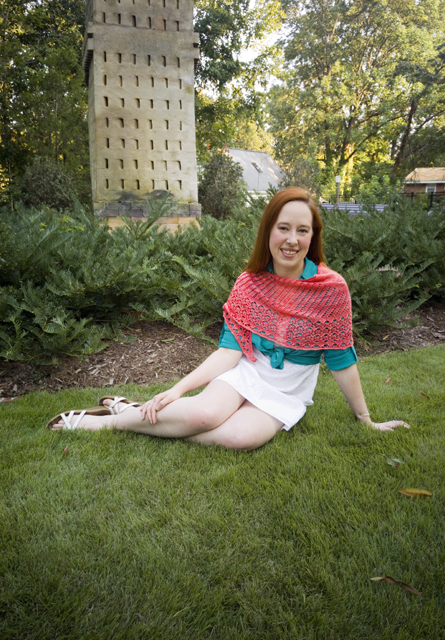
What a beautiful shawl! Hope the weather warms up for us all soon! 🙂 Happy New Year!
Thanks Gillian, and happy New Year to you too! Stay warm!
This is so pretty!!! I’d love to get started with yarn dyeing, would you have some advice for a first project?
Oh, definitely give it a try! The What a Kool Way to Dye group on Ravelry, which is primarily about dyeing yarn with Kool-Aid drink mix, has a lot of good resources about dyeing protein-based fibers with acid-based dyes generally.
Like any project, pick a material you’ll actually want to wear when you’re finished, not just the cheapest yarn available: in this case, a 100% wool or a wool blended with another protein-based fiber like silk or alpaca—no cotton or synthetics. I’ve had good luck with both pure wool and blends. I’d suggest one skein to start: you can use a smaller pot, and things are less likely to get tangled up, and you can get a feel for the process and the results.
For dye, you can use a pre-packaged powdered or liquid dye like those produced by Rit, iDye, or Dharma Trading Company; gel or liquid food dyes (gel produces deeper colors with less volume, liquid can be easier to measure in small quantities); or the aforementioned sugary drink mix and its knock-offs. Which dye you choose depends a lot on what you have available in your local grocery and hobby/craft stores, or are willing to order online; I’ve dyed with both Rit liquid and gel food dye, and I like both. Rit liquid will dye a lot of material—up to 3 pounds of fabric—and the bottles start taking up space quickly, so food dye is a good choice if you want to dye a small quantity of yarn to start. No matter what dye you pick, sticking to a single, solid/semi-solid color will be easier than juggling multiple dye baths or hand-painting sections of yarn.
I’m partial to the stovetop dyeing method over the sink or washing machine methods, since you have more control over the temperature. A thermometer is handy; I really like using a candy thermometer, since they’re designed to clip to a pot full of hot liquid.
There’s tons more information online, from much more experienced people than me, especially if you want to get into more sophisticated projects like creating variegated or self-striping yarn. But the essence of dyeing is simmering a pot of ingredients, so if you can make a soup, you can dye yarn. I’d love to see what you come up with!
Thank you so much for all this info!! That’s amazing, I can’t wait to get started 😀